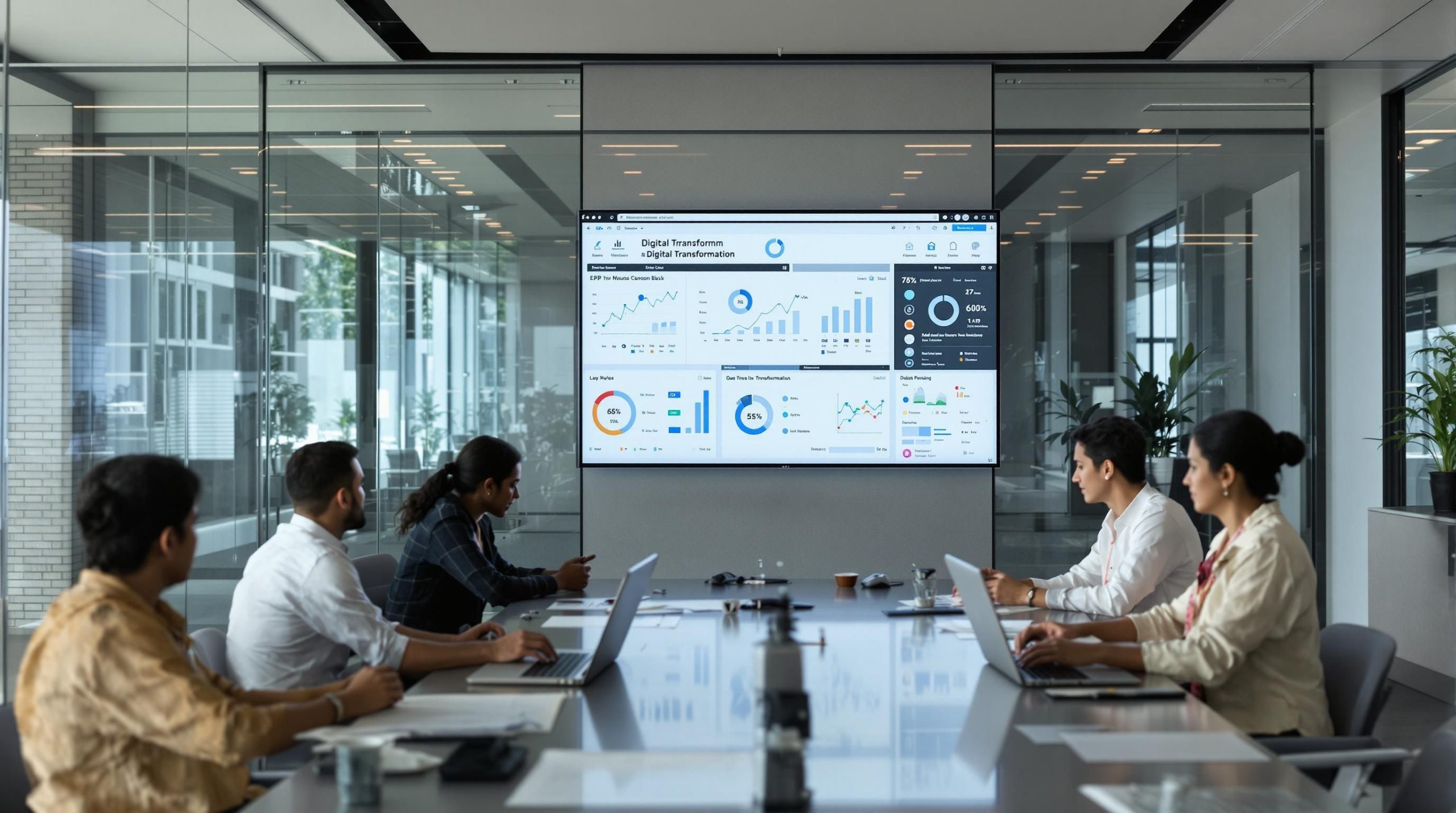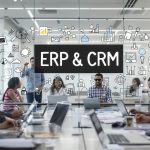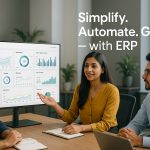ERP implementation is on every Indian business leader’s mind for 2025, with billions expected to be invested in digital transformation next year alone. Surprisingly, most ERP projects still fail, even though over 70 percent of organizations believe a solid change management plan is essential for success. That’s not just bad luck. It actually means organizations are focusing on the wrong things during their ERP rollout.
Table of Contents
- Planning For Successful Erp Implementation
- Choosing The Right Erp Solution And Partner
- Change Management And Staff Training Essentials
- Measuring Erp Success In Indian Industries
Quick Summary
| Takeaway | Explanation |
|---|---|
| Thorough Business Assessment Is Essential | Conduct a detailed evaluation of current workflows and inefficiencies before starting ERP implementation. This ensures tailored solutions to meet specific needs. |
| Select the Right ERP Solution and Partner | Choose a system based on compatibility, scalability, and vendor support, not just cost. Ensure your partner understands your business and offers ongoing support. |
| Emphasize Change Management and Training | Prioritize training and communication to facilitate acceptance and engagement among employees. Tailored training programs increase understanding and productivity. |
| Establish Clear Performance Metrics | Use a comprehensive set of performance indicators to measure ERP success, including operational efficiency, user satisfaction, and strategic value. Regular assessments are crucial for continuous improvement. |
| Continuous Improvement Is a Must | Treat ERP implementation as an ongoing process, adapting to changing business goals and seeking feedback to enhance system effectiveness and user experience. |
Planning for Successful ERP Implementation
Successful ERP implementation demands strategic preparation and meticulous planning. Business leaders must recognize that this is not merely a technological upgrade but a comprehensive organizational transformation that requires careful consideration of multiple critical factors.
Comprehensive Business Requirement Assessment
Before initiating an ERP implementation, organizations must conduct a thorough assessment of their unique business requirements. According to research from Park University, this process involves deeply understanding current workflows, identifying existing operational inefficiencies, and mapping out precise organizational needs.
The assessment should encompass several key dimensions. First, analyze current business processes and document existing pain points. This means scrutinizing everything from inventory management to financial reporting systems. Second, engage stakeholders across different departments to gather comprehensive insights. Department heads, operational managers, and frontline workers each bring unique perspectives that can illuminate critical implementation requirements.
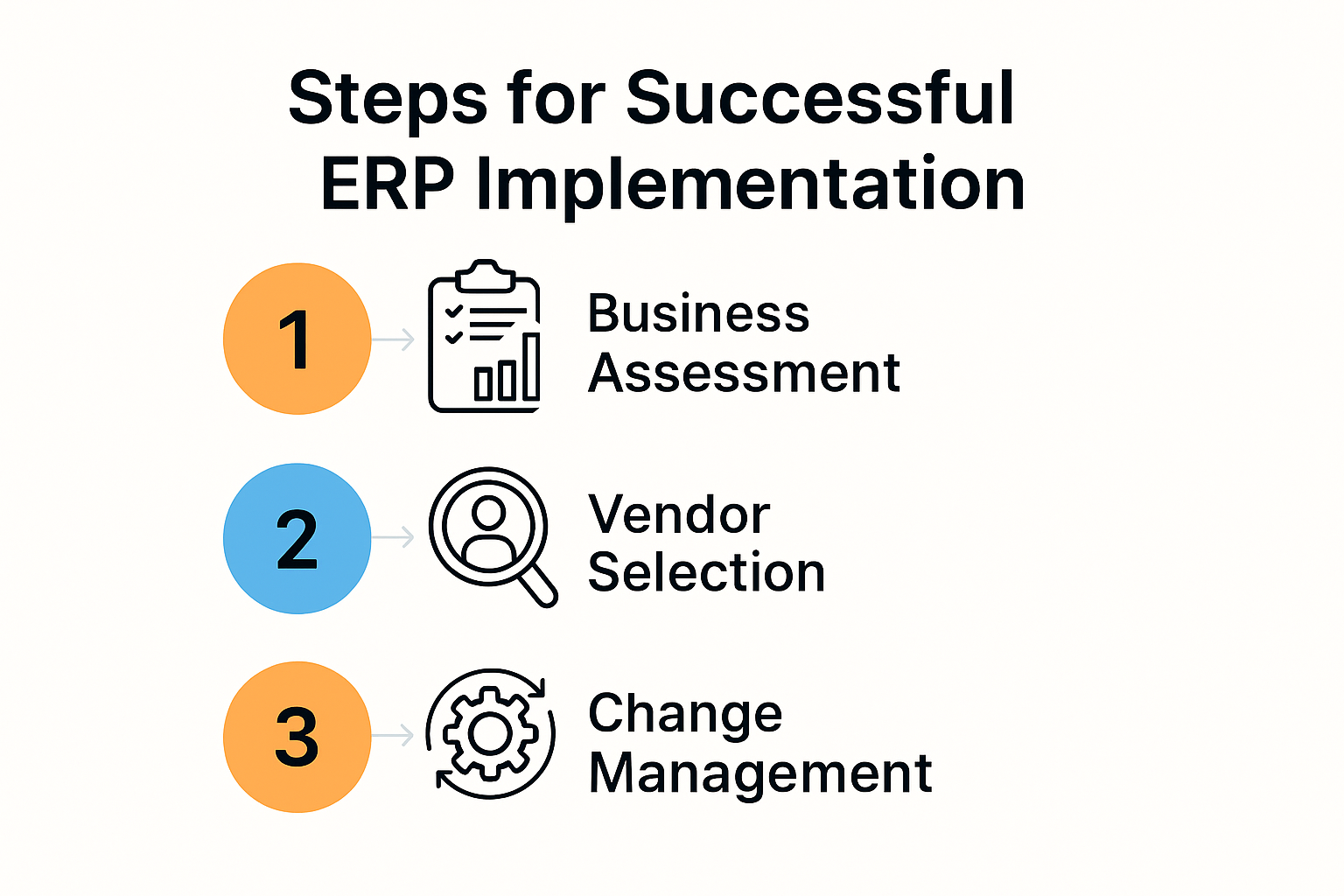
Strategic Vendor and System Selection
Research published in the European Journal of Operational Research highlights the critical importance of systematic vendor and system selection. This isn’t about choosing the most expensive solution but finding the most compatible system that aligns with your organizational structure and future growth trajectory.
Key selection criteria should include system flexibility, scalability, integration capabilities, and vendor support quality. Evaluate potential ERP solutions through multiple lenses: technical compatibility, cost-effectiveness, implementation timeline, and long-term adaptability. Conduct thorough demonstrations, request detailed references, and perform comprehensive technical assessments before making a final decision.
To help business leaders compare potential ERP solutions, the following table summarizes the key criteria for evaluating ERP vendors and systems discussed above:
| Evaluation Criteria | Description |
|---|---|
| System Flexibility | Ability to adapt and customize as business needs evolve |
| Scalability | Supports current operations and future growth |
| Integration Capabilities | Seamless connection with existing systems and third-party applications |
| Vendor Support Quality | Quality, responsiveness, and availability of technical/vendor support |
| Technical Compatibility | Suitability to current IT infrastructure and compliance requirements |
| Cost-Effectiveness | Balance between price and value over the system’s lifecycle |
| Implementation Timeline | Feasibility of vendor’s project delivery schedule |
| Long-term Adaptability | Capacity to accommodate new business models and regulatory requirements over time |
Implementation Roadmap and Change Management
Developing a robust implementation roadmap is crucial for minimizing disruptions and ensuring smooth transition. This roadmap should include realistic timelines, clearly defined milestones, resource allocation strategies, and comprehensive training programs. Technical readiness assessments are equally important, encompassing infrastructure evaluation, data migration strategies, and potential system integration challenges.
Change management represents a fundamental aspect often overlooked by organizations. Successful ERP implementation is not just about technology but about managing human factors. Create communication strategies that transparently explain the reasons behind the ERP implementation, potential benefits, and address potential employee concerns. Develop targeted training programs that empower employees to understand and effectively utilize the new system.
By approaching ERP implementation as a holistic organizational strategy rather than a mere technical project, business leaders can significantly enhance their chances of success. Careful planning, stakeholder engagement, and a comprehensive understanding of organizational needs form the foundation of effective ERP transformation.
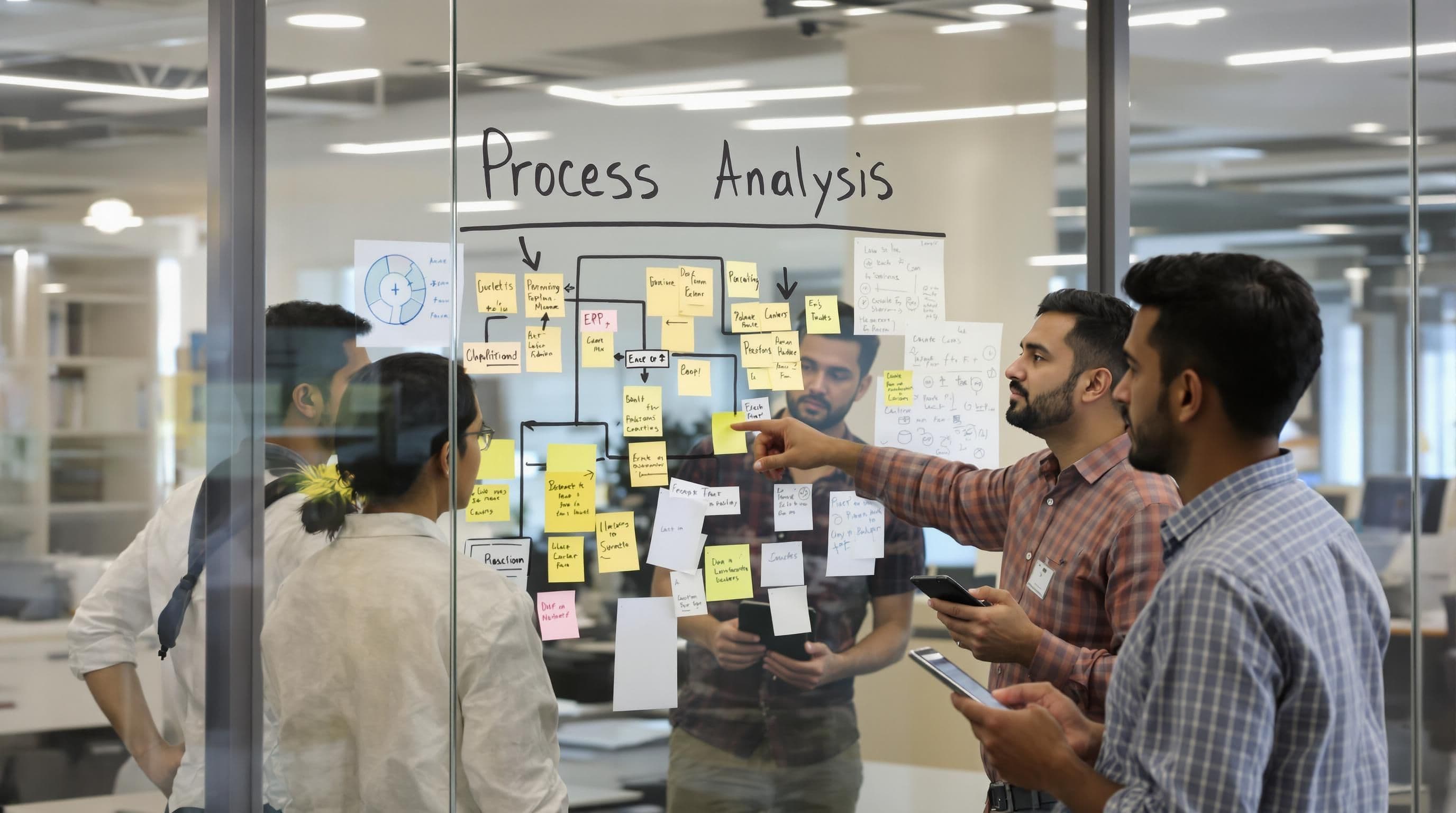
Choosing the Right ERP Solution and Partner
Selecting the appropriate ERP solution and implementation partner represents a critical strategic decision that can significantly impact an organization’s operational efficiency and long-term growth trajectory. Business leaders must approach this process with a comprehensive and methodical strategy that goes beyond surface-level evaluations.
Comprehensive Solution Evaluation Criteria
ERP solution selection requires a multi-dimensional assessment that transcends basic functionality. According to the US Government Accountability Office (GAO) report, organizations must conduct rigorous requirements analysis that considers both immediate operational needs and future scalability.
Key evaluation criteria should include system flexibility, integration capabilities, customization potential, and vendor reputation. Assess potential solutions across several critical dimensions: technical architecture, user experience, reporting capabilities, mobile accessibility, and alignment with industry-specific requirements. Conduct thorough demonstrations and request detailed case studies that showcase successful implementations in similar business contexts.
Partner Selection and Compatibility Assessment
Choosing an implementation partner is equally crucial as selecting the ERP solution itself. Look beyond technical credentials and evaluate potential partners based on their understanding of your specific business ecosystem. Critical selection factors include demonstrated industry expertise, implementation methodology, post-implementation support capabilities, and cultural alignment with your organization.
Seek partners who offer comprehensive implementation strategies that include detailed project planning, change management support, and ongoing technical assistance. Evaluate their track record through references, case studies, and direct conversations with their previous clients. Pay special attention to their approach to knowledge transfer, training programs, and long-term support commitments.
Total Cost of Ownership and Return on Investment
Successful ERP solution selection requires a holistic view of financial implications. Do not focus solely on initial implementation costs but consider the total cost of ownership over a five to ten-year period. This includes software licensing, implementation expenses, infrastructure upgrades, training costs, and potential customization requirements.
Develop a comprehensive financial model that projects potential return on investment. Consider both tangible benefits like operational efficiency and cost savings, and intangible advantages such as improved decision-making capabilities, enhanced reporting accuracy, and increased organizational agility. Request detailed financial projections from potential vendors and implementation partners that demonstrate clear value creation pathways.
The following table breaks down the main components contributing to ERP total cost of ownership versus the types of return on investment to expect, as discussed in this section:
| Cost Component | Description | Potential ROI Benefit |
|---|---|---|
| Software Licensing | Fees for ERP application rights | Operational cost savings |
| Implementation Expenses | Project management, configuration, consulting | Improved process efficiency |
| Infrastructure Upgrades | Hardware, networking, and IT environment updates | Enhanced system performance |
| Training Costs | Staff training and skill development programs | Greater employee productivity |
| Customization Requirements | Adapting ERP to unique business needs | Integration with business processes |
| Post-Implementation Support | Ongoing technical support and system maintenance | Sustained organizational agility |
The process of choosing an ERP solution and implementation partner demands meticulous research, strategic thinking, and a forward-looking perspective. By approaching this decision as a strategic investment rather than a mere technological upgrade, business leaders can transform their organizational capabilities and create sustainable competitive advantages.
Remember that the right ERP solution is not just a tool but a strategic enabler that can fundamentally reshape how your organization operates, makes decisions, and drives growth in an increasingly complex business environment.
Change Management and Staff Training Essentials
Successful ERP implementation extends far beyond technical configuration. The human element represents the most critical factor in transforming technological potential into organizational performance. Change management and staff training are not supplementary activities but core strategic imperatives that determine the ultimate success of any ERP deployment.
Building Organizational Readiness and Stakeholder Engagement
According to NetSuite, securing stakeholder buy-in requires a proactive and comprehensive approach. Organizations must create a dedicated change management team that represents diverse organizational perspectives. This team should communicate transparently about implementation objectives, potential impacts, anticipated timelines, and expected behavioral shifts.
Effective stakeholder engagement involves more than mere information dissemination. It demands creating meaningful dialogue channels where employees can express concerns, provide feedback, and actively participate in the transformation process. Develop communication strategies that address potential resistance, highlight individual and collective benefits, and create a sense of shared organizational purpose.
Strategic Training and Skill Development
Research from TechTarget emphasizes the necessity of comprehensive, role-based training programs. One-size-fits-all approaches are destined to fail. Instead, design targeted training modules that align with specific job roles, skill levels, and individual learning preferences.
ECI Solutions recommends developing training programs that go beyond technical system instructions. These programs should help employees understand how the new ERP system supports improved workflows, enhances productivity, and contributes to broader organizational goals. Incorporate various learning modalities including hands-on workshops, interactive simulations, video tutorials, and ongoing support mechanisms.
Continuous Support and Cultural Transformation
Change management is an ongoing process that extends well beyond initial implementation. Create support structures that provide continuous learning opportunities, technical assistance, and psychological safety for employees navigating new systems. Establish help desks, peer support networks, and regular feedback mechanisms that allow for continuous improvement and adaptation.
Recognize that ERP implementation is fundamentally a cultural transformation. It requires reshaping organizational mindsets, breaking down traditional departmental silos, and fostering a culture of continuous learning and technological adaptability. Leadership must model the behaviors and attitudes required for successful digital transformation.
Successful change management in ERP implementation is not about forcing compliance but inspiring genuine organizational enthusiasm. By treating employees as active participants rather than passive recipients of technological change, businesses can unlock unprecedented levels of operational efficiency and innovation.
The most sophisticated ERP system will fail without human understanding, engagement, and commitment. Investing in comprehensive change management and training is not an expense but a strategic investment in organizational resilience and future competitiveness.
Measuring ERP Success in Indian Industries
Measuring ERP success goes beyond traditional performance metrics. For Indian businesses, it represents a comprehensive evaluation of technological transformation, organizational adaptability, and strategic value creation. Understanding these multidimensional success parameters is crucial for driving continuous improvement and realizing the full potential of enterprise resource planning systems.
Comprehensive Performance Indicators
Research from the International Journal of Supply Chain Management proposes a sophisticated framework for assessing ERP implementation success in the Indian manufacturing sector. This approach transcends simplistic financial measurements, incorporating both tangible and intangible success factors.
Key performance indicators should include operational efficiency metrics, cost reduction percentages, process standardization levels, and system adoption rates. Evaluate the ERP implementation’s impact on critical business dimensions such as inventory management, financial reporting accuracy, decision-making speed, and cross-departmental collaboration. Quantitative metrics must be complemented by qualitative assessments of organizational agility and technological integration.
User Satisfaction and Adoption Metrics
An exploratory analysis of Indian manufacturing enterprises highlights the critical role of user involvement and satisfaction in determining ERP success. Nine key factors emerge as fundamental to successful implementation, with user engagement being paramount.
Conduct comprehensive user satisfaction surveys that measure system usability, training effectiveness, and perceived organizational value. Track metrics such as system login frequencies, feature utilization rates, and user-generated improvement suggestions. Pay special attention to how different organizational levels interact with the ERP system, from frontline workers to executive management.
Strategic Value and Continuous Improvement
Research from the Turkish Journal of Computer and Mathematics Education demonstrates that ERP success is not a one-time achievement but an ongoing journey of adaptation and refinement. The study emphasizes the importance of continuous measurement and strategic realignment.
Establish a dynamic evaluation framework that allows for periodic reassessment of ERP implementation against evolving business objectives. This involves creating feedback loops, conducting regular system audits, and maintaining flexibility in technological adaptation. Consider both short-term operational improvements and long-term strategic capabilities introduced by the ERP system.
Successful ERP measurement in Indian industries requires a holistic approach that balances technological performance, human factors, and strategic alignment. It is not merely about implementing a system but about transforming organizational capabilities, enhancing decision-making processes, and creating a foundation for sustainable digital transformation.
Remember that true ERP success is measured not just in numbers but in an organization’s increased ability to navigate complexity, respond to market changes, and drive continuous innovation. The most effective measurement approaches view ERP implementation as a strategic journey of organizational evolution rather than a static technological upgrade.
Frequently Asked Questions
What are the best practices for ERP implementation in Indian businesses?
Effective ERP implementation involves comprehensive business requirement assessment, strategic vendor and system selection, robust change management, and continuous employee training.
How can Indian business leaders ensure stakeholder engagement during ERP implementation?
Business leaders should create a dedicated change management team, communicate transparently about the implementation process, and facilitate channels for employee feedback to enhance stakeholder buy-in.
What factors should be considered when choosing an ERP solution?
Key factors include system flexibility, scalability, integration capabilities, vendor support quality, and total cost of ownership over the system’s lifecycle.
How is ERP success measured in Indian industries?
ERP success is measured using a combination of performance indicators such as operational efficiency, user satisfaction, cost reductions, and continuous strategic alignment with business objectives.
Ready to Achieve Seamless ERP Implementation in 2025?
Making your ERP vision a reality is not just about choosing good software. It is about addressing deep operational challenges, managing change, and ensuring measurable results. As highlighted in this article, Indian business leaders struggle with fragmented workflows, low adoption rates, and the overwhelming complexity of aligning new systems with long-term growth. You need solutions that go beyond checklists and deliver meaningful business transformation. That is where Wider ERP from Zymofar steps in.
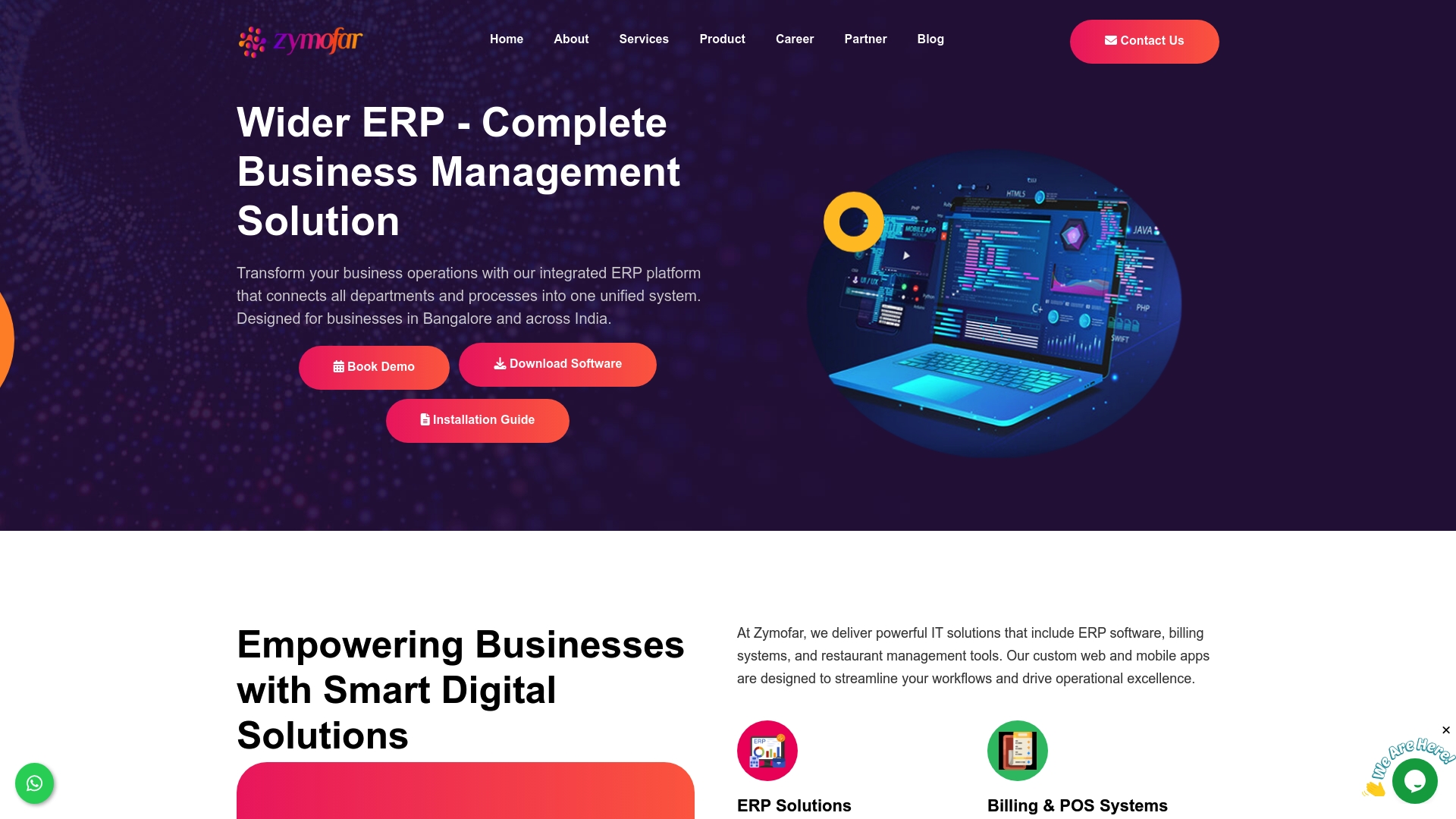
Experience how AI-powered automation, predictive analytics, smart inventory management, and chatbot support can turn your ERP investment into a genuine growth engine. Start reducing inefficiencies, enhance user adoption, and gain real-time insights for smarter decisions. Visit Zymofar today to learn how our end-to-end support, custom integrations, and demo options can help your business move forward with confidence. Take the next step now and unlock your path to data-driven excellence. Request your demo or connect with an expert right here: Wider ERP details.
